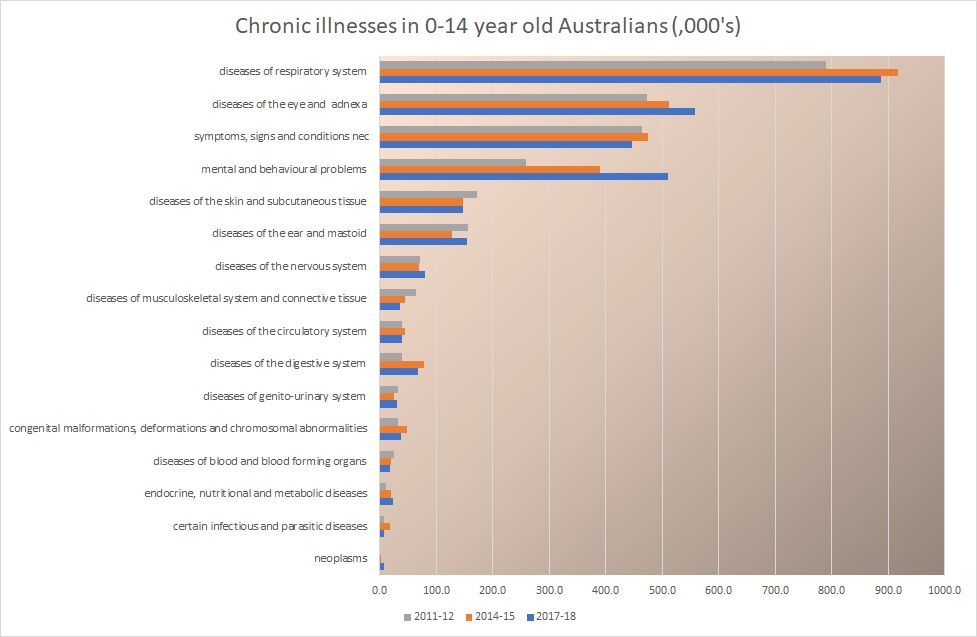CHD statistics: toxity and mortality
PUBLISHED AUSTRALIAN AND INTERNATIONAL DATA
| Leading cause of death in Children – Suicide |
Statistics for children aged 5-17 in 2020
- There were 99 suicides of children.
- Suicide remained the leading cause of death of children in Australia.
In the age group 0-19
- There were 200 suicides
| Autism in Australia |
- 2009 – 64,400 0.3% of the population
- 2012 – 115,400 0.5% of the population (79% increase from 2009 figures)
- 2015 – 164,000 0.7% of the population
- 2018 – 205,200 0.8% of the population
| Prevalence of autism, by age group, 2009, 2012 and 2015 | ||||||||
| 2009 | 2012 | 2015 | ||||||
| Age group (years) |
Estimate (‘000) |
Per cent | Estimate (‘000) |
Per cent | Estimate (‘000) |
Per cent | ||
| 0–4 | *2.8 | *0.2 | 6.0 | 0.4 | *6.2 | *0.4 | ||
| 5–9 | 19.0 | 1.4 | 33.0 | 2.3 | 41.9 | 2.8 | ||
| 10–14 | 17.8 | 1.3 | 26.4 | 1.9 | 39.4 | 2.8 | ||
| 15–19 | 12.5 | 0.8 | 21.8 | 1.5 | 26.4 | 1.8 | ||
| 20–24 | *3.3 | *0.2 | 11.5 | 0.7 | 20.0 | 1.2 | ||
| 25 and over | 8.1 | 0.1 | 17.6 | 0.1 | 26.5 | 0.2 | ||
| Total | 64.6 | . . | 115.4 | . . | 164.0 | . . | ||
| *Estimate has a relative standard error of 25% to 50% and should be used with caution. | ||||||||
| Note: Figures are rounded and discrepancies may occur between sums of the component items and totals because of ABS confidentiality and perturbation processes. | ||||||||
| Source: ABS (Australian Bureau of Statistics) 2016. Microdata: disability, ageing and carers, Australia, 2015. ABS cat. no. 4430.0.30.002. Canberra: ABS. AIHW analysis of TableBuilder. | ||||||||
| Toxins |
“A Swedish study earlier this year found that genetic risk for autism accounted for only 50% of overall risk, leaving an interplay of environmental factors to account for the rest.
Scientists are sounding the alarm on environmental chemicals linked to a long list of neurodevelopmental disabilities in children, ranging from autism, ADD, dyslexia and other cognitive impairments. “We need to know if some moms are at higher risk than others and what that risk is. Knowing who is most vulnerable is key to understanding how to better protect them,” said Janie Shelton, PhD, the CHARGE study’s lead author”
IQ point loss in relation to toxins:
Total losses of IQ points in US children 0–5 years of age associated with major risk factors, including developmental exposure to industrial chemicals that cause neurotoxicity:
| Number of IQ points lost Nationally | |
| Major medical and neurodevelopmental disorders | |
| Preterm birth | 34,031,025 |
| Autism spectrum disorders | 7,109,899 |
| Paediatric bipolar disorder | 8,164,080 |
| Attention-deficit hyperactivity disorder | 16,799,400 |
| Postnatal traumatic brain injury | 5,827,300 |
| Environmental chemical exposures | |
| Lead | 22,947,450 |
| Methylmercury | 1,590,000* |
| Organophosphate pesticides | 16,899,488 |
| Other neurotoxicants | Unknown |
IQ=intelligence quotient. Data from from Bellinger.94
*From Grandjean and colleagues.95
Neurobehavioural effects (NCBI)
Pesticides/ Organophosphate Insecticides:
5 times the risk of child being diagnosed with Acute Myeloid Leukemia (when assessing exposure levels of the mother before, during and 3 months post pregnancy)
- 2 times the risk of child being diagnosed with Acute Lymphoid Leukemia (when assessing exposure levels of the mother before, during and 3 months post pregnancy)
- 60% increase in risk of child being diagnosed with autism (for women living inside 1.6 kilometers of crops sprayed with organophosphates)
- 87% increase in risk of child being diagnosed with autism (for women in 3rd trimester, for a class of pesticides called ‘synthetic pyrethroids’ – often touted as safer alternative to organophosphates, used around homes)
- 3 fold increase in children diagnosed with autism (for women in the second trimester living near fields treated with chlorpyrifos)
Pesticides and autism (beyond pesticides)
Pesticides and leukemia (beyond pesticides)
Very high exposures:
- Adverse birth outcomes increased by 5–9%
Extreme exposures:
- 11% increased probability of preterm birth
- 20% increased probability of low birth weight
- ~30 g decrease in birth weight.”
Pesticides and birth abnormalities (beyond pesticides)
Endocrine-Disrupting Chemicals (EDCs)
Including BPA’s and PFC’s (plastics)
Health Effects include:
- Disruption of the female reproductive tract development, testosterone synthesis and sexual differentiation, leading to adult testis dysfunction, and infertility
- endometriosis,
- Infertility,
- Obesity, Diabetes,
- Early puberty,
- Susceptibility to infections,
- Autoimmune diseases,
- Learning disabilities,
- Neurodegenerative diseases,
- Heart disease
95% of the human population reports measurable levels of BPA in their bodies, including in newborn babies with a high level in plasma, liver, and amniotic fluid.
Environment in children’s health (NCBI)
Flouride
Prominent examples of a growing body of literature indicate that fluoride is a developmental neurotoxicant in humans, harming in particular the IQ of developing children (see table below).
BMD analysis of IQ and total fluoride dose in Wamiao and Xinhuai [6, 10]. The benchmark dose analysis of IQ and the total daily fluoride dose in low-F Xinhuai village (F) and high-F Wamiao village (A–E). The letter designations F and A–E correspond to the groups listed in Table 1. The Benchmark Response (BMR) was set at a loss of 5 IQ points. IQ = 103.17 ‑ (3.0675 × total fluoride dose). The error bars are the 95% confidence intervals for IQ. BMDL = Benchmark dose lower-confidence level; BMD = Benchmark dose. The values for the total daily dose of fluoride are from Xiang et al. [6, 10] as noted in the footnote to Table 1. The values for the IQ are from Table 8 in Xiang et al. [6].
Developmental neurotoxicity of fluoride (intechopen)
Heavy metals
Heavy metals pass through the blood–brain barrier and accumulate in brain tissue. Once in the brain, they harm neurological function through several mechanisms:
- Displacing essential minerals such as zinc and iron that are required for neurotransmitter production.
- Inducing oxidative stress, which reduces neuronal plasticity and impairs learning and behavior.
- Aluminum accumulates in immune cells of the brain. This may provoke an inflammatory immune response that ultimately affects neurological function and behavior.
- Mercury:
- Prenatal mercury exposure, measured through samples of cord blood, is associated with ADHD symptoms in children.
- A systematic review of 44 studies concluded that mercury levels were significantly higher in the whole blood, red blood cells, and brains of autistic subjects compared to controls.
- Mercury content in ambient air is linked to an increased prevalence of autism in children
- Even low levels of mercury are harmful to the developing brain and have been associated with learning disabilities.
- Lead
- n animal studies, prenatal exposure to lead has been found to alter synapses in the brain, impairing neurotransmission and learning behaviors.
- Children who grew up near the location of a former lead refinery were found to have a higher risk of ADHD.
- Even very low levels of lead have adverse effects on the brain and behavior in children. Blood lead levels less than 1.8µg/dL, (well below the CDC’s recommended threshold of 5µg of lead per dL of blood), are associated with an increased risk of ADHD. This suggests that there is no safe limit for lead exposure in children.
- Manganese
- Manganese exposure has been linked to ADHD.
- Children exposed to high levels of manganese through drinking water have been found to experience diminished intellectual function and behavioral problems.
Heavy metals and behavioural disorders in children (Chris Kresser)

| CHD USA Articles |
Incidence of childhood cancers skyrockets
